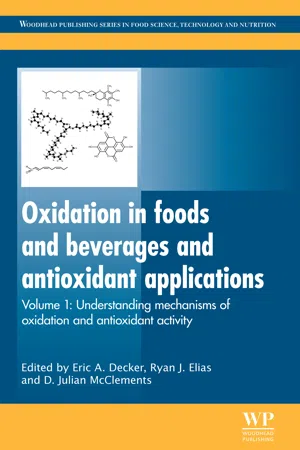

Oxidation in Foods and Beverages and Antioxidant Applications
Understanding Mechanisms of Oxidation and Antioxidant Activity
- 432 pages
- English
- ePUB (mobile friendly)
- Available on iOS & Android
Oxidation in Foods and Beverages and Antioxidant Applications
Understanding Mechanisms of Oxidation and Antioxidant Activity
About this book
Oxidative rancidity is a major cause of food quality deterioration, leading to the formation of undesirable off-flavours as well as unhealthful compounds. Antioxidants are widely employed to inhibit oxidation, and with current consumer concerns about synthetic additives and natural antioxidants are of much interest. The two volumes of Oxidation in foods and beverages and antioxidant applications review food quality deterioration due to oxidation and methods for its control.The first volume focuses on oxidation mechanisms and antioxidant activity. Initial chapters in part one describe oxidation processes in foods, including the role of metals, heme proteins and lipoxygenase. The impact of oxidation on food flavour and the health aspects of oxidized fats are also covered. Final chapters in part one review the measurement of the extent of lipid oxidation and methods for food shelf-life determination. Part two discusses the ways in which antioxidants inhibit food oxidation, factors affecting antioxidant efficacy, methods to measure antioxidant activity and novel antioxidants.With its distinguished international team of editors and contributors, the two volumes of Oxidation in foods and beverages and antioxidant applications is standard references for R&D and QA professionals in the food industry, as well as academic researchers interested in food quality.- Describes oxidation processes in foods, including the role of metals, heme proteins and lipoxygenase- Reviews the impact of oxidation on food flavour and the health aspects of oxidized fats- Discusses the ways in which antioxidants inhibit food oxidation, factors affecting antioxidant efficacy and methods to measure antioxidant activity
Frequently asked questions
- Essential is ideal for learners and professionals who enjoy exploring a wide range of subjects. Access the Essential Library with 800,000+ trusted titles and best-sellers across business, personal growth, and the humanities. Includes unlimited reading time and Standard Read Aloud voice.
- Complete: Perfect for advanced learners and researchers needing full, unrestricted access. Unlock 1.4M+ books across hundreds of subjects, including academic and specialized titles. The Complete Plan also includes advanced features like Premium Read Aloud and Research Assistant.
Please note we cannot support devices running on iOS 13 and Android 7 or earlier. Learn more about using the app.
Information
Understanding oxidation processes in foods
Abstract:
1.1 Introduction
1.2 Reactive oxygen and nitrogen species

















Table of contents
- Cover image
- Title page
- Table of Contents
- Copyright
- Contributor contact details
- Woodhead Publishing Series in Food Science, Technology and Nutrition
- Preface
- Part I: Oxidation in foods and beverages
- Part II: Antioxidants in foods and beverages
- Index